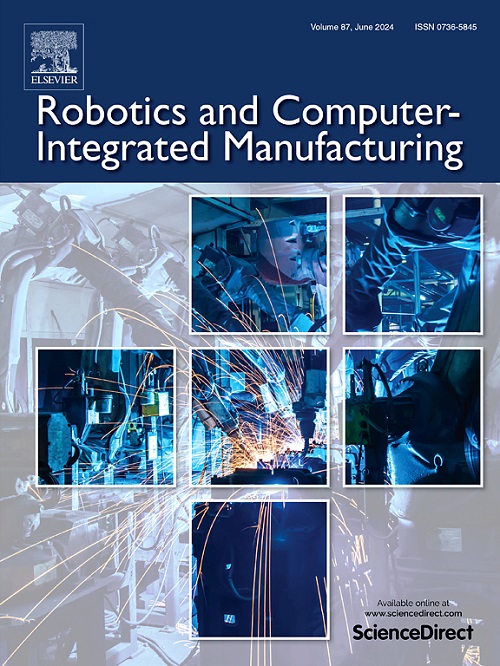A Novel Point Cloud-Driven Framework for Enhanced Multi-Views Model Reconstruction and Robotic Arc Welding Trajectory Generation
IF 11.4
1区 计算机科学
Q1 COMPUTER SCIENCE, INTERDISCIPLINARY APPLICATIONS
引用次数: 0
Abstract
With the rapid advancement of robotics technology, robotic welding has become essential for improving the welding efficiency of large-scale complex components, while reducing the workload of welders. However, the large size and intricate weld structures present significant challenges in obtaining comprehensive point cloud and accurate welding paths, which further hinders the development and application of robotic welding in this field. To address these problems, this article proposes a novel point cloud-driven framework for enhanced multi-views model reconstruction and robotic arc welding trajectory generation of large-scale complex components. To determine the corresponding point pairs and optimal transformation used for point cloud alignment, we introduce an improved bidirectional nearest neighbor (IBNN) algorithm combined with a Levenberg-Marquardt iterative closest point (LM-ICP) approach, which enables precise and fast stitching of multi-views point clouds. We further propose an edge intensity (EI) response algorithm for efficient extraction of weld seams feature points from the point cloud, followed by B-spline curve fitting to generate smooth and accurate welding trajectories. Additionally, the welding torch pose is estimated by integrating the weld seams region (WSR) point cloud with the welding trajectories, enabling the robot to perform autonomous welding in the correct orientation. Experimental results show that the proposed framework outperforms traditional methods in both accuracy and efficiency, with a maximum error (ME) of about 0.6 mm, a root mean square error (RMSE) of approximately 0.4 mm, and a running time of around 7 s, which has a certain industrial application value.
一种新的点云驱动框架,用于增强多视图模型重建和机器人弧焊轨迹生成
随着机器人技术的飞速发展,机器人焊接已成为提高大型复杂构件焊接效率、减少焊工工作量的必要手段。然而,由于焊缝结构尺寸大、结构复杂,难以获得全面的点云和准确的焊接路径,这进一步阻碍了机器人焊接在该领域的发展和应用。为了解决这些问题,本文提出了一种新的点云驱动框架,用于增强多视图模型重建和大型复杂部件的机器人弧焊轨迹生成。为了确定相应的点对和用于点云对齐的最优变换,我们引入了一种改进的双向最近邻(IBNN)算法,结合Levenberg-Marquardt迭代最近邻(LM-ICP)方法,实现了多视图点云的精确、快速拼接。我们进一步提出了一种边缘强度(EI)响应算法,用于从点云中有效地提取焊缝特征点,然后进行b样条曲线拟合以生成光滑准确的焊接轨迹。此外,通过将焊缝区域(WSR)点云与焊接轨迹相结合来估计焊枪姿态,使机器人能够在正确的方向上进行自主焊接。实验结果表明,该框架在精度和效率上均优于传统方法,最大误差(ME)约为0.6 mm,均方根误差(RMSE)约为0.4 mm,运行时间约为7 s,具有一定的工业应用价值。
本文章由计算机程序翻译,如有差异,请以英文原文为准。
求助全文
约1分钟内获得全文
求助全文
来源期刊
CiteScore
24.10
自引率
13.50%
发文量
160
审稿时长
50 days
期刊介绍:
The journal, Robotics and Computer-Integrated Manufacturing, focuses on sharing research applications that contribute to the development of new or enhanced robotics, manufacturing technologies, and innovative manufacturing strategies that are relevant to industry. Papers that combine theory and experimental validation are preferred, while review papers on current robotics and manufacturing issues are also considered. However, papers on traditional machining processes, modeling and simulation, supply chain management, and resource optimization are generally not within the scope of the journal, as there are more appropriate journals for these topics. Similarly, papers that are overly theoretical or mathematical will be directed to other suitable journals. The journal welcomes original papers in areas such as industrial robotics, human-robot collaboration in manufacturing, cloud-based manufacturing, cyber-physical production systems, big data analytics in manufacturing, smart mechatronics, machine learning, adaptive and sustainable manufacturing, and other fields involving unique manufacturing technologies.

 求助内容:
求助内容: 应助结果提醒方式:
应助结果提醒方式:


